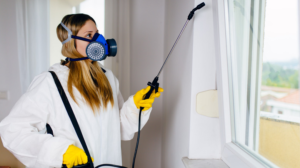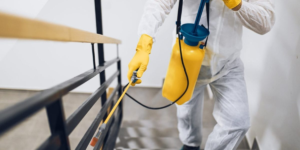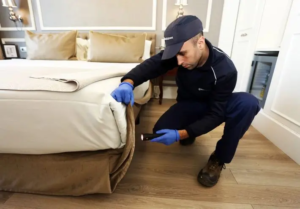Pests can cause economic damage to crops, trees, livestock and buildings. They also can be carriers of diseases like hantavirus, leptospirosis and Salmonella.
Monitoring is key to determining whether pests can be tolerated or need control. Plant disease organisms, for example, often only grow under certain environmental conditions. Contact Pest Control Simi Valley CA now!

Eliminate attractants by sealing trash cans, cleaning clogged gutters and closing spaces where pipes enter homes with caulk, metal mesh or urethane expandable foam.
Prevention
In the garden, home or workplace, pest prevention focuses on discouraging the growth of pests. This is usually achieved through preventing them from finding food, water or shelter. Preventive measures include removing conducive conditions such as weeds, debris and overhanging branches. Regular cleaning routines also play an important role, as pests are attracted to dirty and cluttered spaces. Educating household members and employees on effective pest control practices is also a crucial element in prevention.
If the population of a pest has reached unacceptable levels, it is necessary to control it. However, this should be done in a way that does not harm people or property, or damage the environment. Pesticides can be used for control but are usually a last resort. Before using any pesticides, they must be carefully selected and applied according to strict guidelines.
Monitoring means checking a field, garden, landscape, building or other site on a regular basis to identify and assess the presence of pests and the damage they have caused. This information is critical in deciding whether a pest can be tolerated or if it needs to be controlled and what management strategy is appropriate.
Observing and studying the natural habits of a pest is another key part of pest control. For example, a pest’s life cycle, feeding habits, favored habitat and other characteristics can be learned by observing it in its natural setting. This can then help in developing an efficient control strategy.
A variety of natural forces affect pest populations, causing their numbers to rise and fall. These include climate, natural enemies, availability of food and water, natural barriers and the availability of shelter. In addition, predators and parasitic insects and pathogens can significantly suppress pest populations.
Often, pests invade buildings in search of food, water or shelter. To prevent them from entering, all entrance points should be sealed and a thorough inspection carried out to identify attractants. This will lead to corrective action such as caulking or steel wool for sealing smaller gaps, door sweeps and weather stripping for doors and windows. Moisture is a major attraction for many pests and can be reduced by maintaining adequate ventilation, repairing leaking taps and installing dehumidifiers.
Suppression
Many pest control problems can be handled without using pesticides. Those that cannot are best addressed with integrated pest management (IPM) techniques. IPM combines prevention, monitoring and suppression in an attempt to minimize the use of toxic chemicals. Pesticides are used only when they are required, and only in the most appropriate manner. Pesticides are chosen and applied with consideration for their effect on beneficial organisms, other plants, the environment and human health.
Preventing pests from infesting a site is the first step in IPM. This includes such tactics as using pest-free seeds or transplants, watering and irrigation scheduling to avoid conditions conducive to disease development, field sanitation procedures and elimination of alternate hosts or sites for insect pests.
The next steps involve monitoring and scouting to identify pests, determine their severity and track the progress of IPM controls. Detailed records of pest incidence and distribution provide information for crop rotation selection, economic thresholds and suppressive actions.
A few types of pests require more intensive intervention. This may include eradication (destroy the pest population), quarantine or other physical removal measures, such as trapping and exclusion. Biological methods may also be used. These usually involve the introduction of natural enemies into the area to prey on the pest, such as predators or parasites. There is usually a time lag between the increase in the number of natural enemies and the reduction in pest numbers.
Other mechanical or physical controls can be used to disrupt the normal behavior of pests or their environment. Traps, screens, barriers, fences and radiation sometimes are used to interrupt or deter pests. Altering the amount of food or hydration in an area can also be effective, as can changes to temperature and humidity.
The goal of any pest control activity should be to cause as little harm as possible to people, property and the environment. This is particularly true when it comes to the use of pesticides. Choosing the right tactic is critical for IPM success, and this requires knowledge of the pest to be controlled, its environment and its history with humans.
Eradication
When pests are causing damage to property, health problems or simply making people uneasy, they must be dealt with. Pest control is the process of managing unwanted creatures such as rodents, ants, cockroaches and termites. It includes the inspection of properties, setting traps and baits, spraying and dusting. It also involves the use of chemical pesticides, which must only be used by a qualified professional who follows strict EPA guidelines.
Prevention is the best method of pest control. Regular cleaning of floors, counters and storage areas, promptly discarding of garbage, sealing open food packages, and trimming back bushes that touch the home are effective preventive measures. Sealing cracks and crevices, including those where pipes enter the house, and installing door sweeps and weatherstripping can help keep pests out.
A thorough inspection by a trained technician is the first step in solving a pest problem. During the inspection, the technician will identify entry points and nesting sites, as well as pinpoint areas of moisture accumulation. Based on the findings of the inspection, the technician will develop a customized treatment plan.
Depending on the type of pest, methods of extermination may include baiting, trapping, or spraying. The most severe method of extermination is fumigation, in which a room or building is pumped with pesticide gas to kill the pests inside. This method is rarely used, as it poses a risk to the health of those in the home or business.
Although pesticides can be an effective tool in controlling pests, they should never be used without proper training and adherence to EPA guidelines. Using pesticides incorrectly can be more dangerous than the pests themselves. If pesticides must be used, the occupants of the affected property should be evacuated during treatment and for several hours afterward. After a successful eradication, the property should be thoroughly cleaned and sealed to deter future infestations. The word eradicate derives from the Latin eradicare, meaning to pull up by the roots. While this is often the goal of a pesticide treatment, preventing an infestation before it occurs should always be the primary concern.
IPM
An important alternative to pesticides is Integrated Pest Management (IPM). IPM is an ecosystem-based decision-making process that uses knowledge of pest biology, environmental data and technology to manage pests in ways that minimize risks to people and the environment. It can be applied to all landscapes, including urban, agricultural and wildland/natural areas, such as parks, school grounds and recreational facilities.
IPM involves prevention, monitoring, correct identification, and the use of non-chemical controls. It starts with routine inspections to determine whether a pest infestation is present and to assess damage levels. If pests are detected, an action threshold is triggered and management options are considered. Preventive methods, such as crop rotation, planting pest-resistant varieties and aerating or cultivating soils, are used to keep populations below damaging levels.
In addition, non-chemical control measures include the release of natural enemies such as predators and parasites to kill or reduce pest infestations. This is a very effective way to reduce the need for chemical controls, but it requires careful study and implementation. For example, aphids can be killed by spraying them with insecticides, but they are also easily controlled by encouraging natural predators such as ladybugs and lacewings to move in on the site and devour the insects.
If preventive measures fail, and an action threshold is triggered, then IPM programs evaluate the benefits and risks of various control methods in order to select the best one. Non-chemical options, such as trapping, heat treatments and cutting or mowing to disrupt breeding, are often the first choices, followed by the use of chemical controls. These are usually based on direct toxins, which are delivered to the pests through their skin or mouth, rather than poisoning the whole plant.
IPM is a complex process that should involve the expertise of several professionals, including entomologists, plant pathologists and nematologists, as well as the cooperation of landscapers, homeowners, businesses and gardeners. The goal is to produce a sustainable method of managing pests that will provide economic returns, while minimizing risk to people and the environment. It’s critical that anyone implementing IPM procedures is aware of the potential for pest resistance to develop, which can occur as a result of overuse of a single type of pest control.

